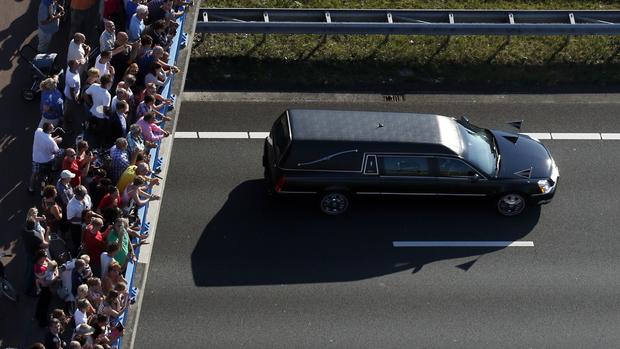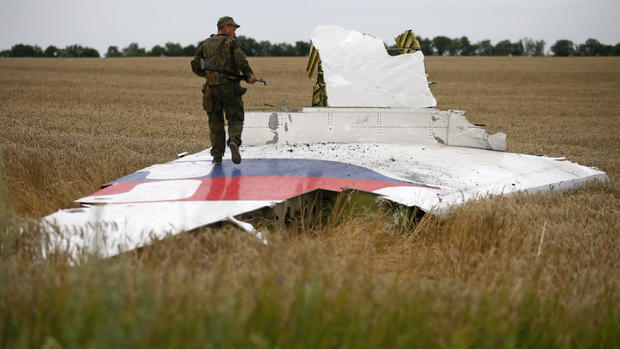Somber homecoming: First Flight 17 victims arrive in Netherlands
EINDHOVEN, Netherlands -- Two military transport planes carrying 40 coffins bearing victims of the downing of Malaysia Airlines Flight 17 landed Wednesday in the southern city of Eindhoven, and pro-Russian rebels said they shot down two Ukrainian fighter jets in the east as fighting flared in the region.
Six days after the Boeing 777 was shot down over the battlefields of eastern Ukraine, the first bodies finally arrived in the Netherlands, the country that bore the heaviest toll in the crash that killed all 298 passengers and crew.
A Dutch Hercules C-130 that Dutch government spokesman Lodewijk Hekking says is carrying 16 coffins was closely followed by an Australian C-17 Globemaster plane carrying 24 coffins.
Even though they are still unidentified, the corpses that arrived in Eindhoven were embraced by a nation unmoored by the loss of so many people caught in someone else's faraway war.
Boys going to visit their grandparents, a flight attendant in a hurry to get home, a bouncer heading to see his sweetheart were among the 298 victims of Malaysia Airlines Flight 17, whose downing last week has intensified anger at the pro-Russian rebels suspected of bringing the plane down.
Investigators in a lab in southern England began studying the plane's black box recorders Wednesday in hopes of finding clues to what happened. The Dutch Safety Board, which has taken control of the investigation, said the voice recorder suffered damage but showed no sign of manipulation, and its recordings were intact. Specialists will start studying the flight data recorder Thursday.
The two military transport planes, one Dutch and one Australian, departed Ukraine at midday, and landed at Eindhoven Air Base where the flights were met by Dutch King Willem-Alexander, Queen Maxima, Prime Minister Mark Rutte and other government officials. Hundreds of relatives were also there, according to government spokesman Lodewijk Hekking. He said the planes carried 40 coffins in all.
"If I have to wait five months for identification, I can do it," said Silene Fredriksz-Hoogzand, whose son, Bryce, and his girlfriend Daisy Oehlers died in the crash. "Waiting while the bodies were in the field and in the train was a nightmare."
On a day of national mourning, flags flew at half-staff on Dutch government buildings and family homes around this nation of 17 million.
Church bells rang out around the country as the planes taxied to a standstill. King Willem-Alexander clasped his wife Queen Maxima's hand as the couple grimly watched teams carry the coffins slowly from the planes to a fleet of waiting hearses.
Almost the only sound was of boots marching across the ground and flags flapping in the wind.
CBS News' Elizabeth Palmer said there would be other aircraft landing at Eindhoven from Kharkiv on Wednesday, including two Dutch military Hercules cargo planes. Those planes, too, were expected to be carrying remains, and possibly luggage and personal effects from the ill-fated flight, in addition to members of the Dutch forensic team.
It was unclear how many of the 282 corpses reported found so far were on the train which arrived in Kharkiv, a government-controlled city, on Tuesday, but as CBS News' Mark Phillips reported, it was clear that not as many bodies were on the train as hoped.
Jan Tuinder, the Dutch official in charge of the international team dealing with the dead, said that at least 200 bodies were aboard the train and that more remains could be found once the body bags were examined fully.
A European observer told Phillips on Tuesday that they were still seeing "body parts, not whole bodies" amid the wreckage at the crash site, and he was concerned by the "invasive" actions by locals and pro-Russian rebels moving and even cutting apart the pieces of the shattered plane before investigators arrived.
Ukraine and Western nations are pressing the pro-Russian rebels who control the crash site to allow an unfettered investigation, something Russian President Vladimir Putin said he would use his influence to achieve. Though confident that a missile brought down the passenger jet, U.S. officials say Russia's role remains unclear.
Ukraine's defense ministry said two fighter planes were shot down about 20 miles south of the site of the Malaysia Airlines wreckage. The separatist Donetsk People's Republic said in a statement on its website that one of the pilots was killed and another was being sought by rebel fighters.
While the insurgents deny having missiles capable of hitting a jetliner at cruising altitude, rebel leader Alexander Borodai has said that separatist fighters do have Strela-10M ground-to-air missiles which are capable of hitting targets up to an altitude of 3,500 meters (11,500 feet).
In fighting on the ground Wednesday, rebel leader Pavel Gubarev wrote on his Facebook page that his men retreated Wednesday from the villages of Chervona Zorya and Kozhevnya, on the Russian border about 45 kilometers (30 miles) from the scene of the crash. Gubarev said 30 rebels had been injured.
Britain's Air Accidents Investigation Branch said Wednesday that Dutch authorities had delivered the plane's voice and data recorders to the agency's base at Farnborough, southern England, where information will be downloaded. Experts will also check for signs of tampering.
The Dutch Safety Board, which is leading an international team of 24 investigators, and said unhindered access to the crash site is critical.
Spokesman Tjibbe Joustra told The Associated Press in a telephone interview that around 25 investigators already are in Kiev analyzing information including photos, satellite images and radar information, but have not yet gained access to the crash site.
"We haven't yet gotten guarantees about security for our way of working. If we go we have to be able to move freely," he said. "We hope to be able to get to the site soon."
Independent military analysts said Wednesday that the size, spread, shape and number of shrapnel impacts visible in an AP photograph of a piece of the wreckage all point to a missile system like the SA-11 Buk.
U.S. analysts have also concluded that an SA-11 was the likely weapon.
Konrad Muzyka, Europe and CIS armed forces analyst at IHS Jane's, said the high number of shrapnel holes in the debris meant that only a fragmentary warhead like the SA-11 could have been used. "The Buk has a 70-kilogram (155-pound) warhead which explodes and sends shrapnel out," he said. The fact the shrapnel holes are folded inwards confirmed that the explosion came from outside the plane, he added.
Justin Bronk, military sciences research analyst at the Royal United Services Institute, said "the size of shrapnel holes is fairly broad, in keeping with what you would expect from a large missile like the SA-11."
The European Union on Tuesday imposed sanctions against more Russian individuals but refrained from targeting entire sectors of the Russian economy while waiting for clearer evidence of Moscow's role in the disaster.
Senior U.S. intelligence officials said Tuesday that Russia was responsible for "creating the conditions" that led to the crash, but they offered no evidence of direct Russian government involvement.
The officials, who briefed reporters Tuesday under ground rules that their names not be used, said the plane was likely shot down by an SA-11 surface-to-air missile fired by Russian-backed separatists. They cited intercepts, satellite photos and social media postings by separatists, some of which have been authenticated by U.S. experts.
The intelligence officials were cautious in their assessment, noting that while the Russians have been arming separatists in eastern Ukraine, the U.S. had no direct evidence that the missile used to shoot down the passenger jet came from Russia.


